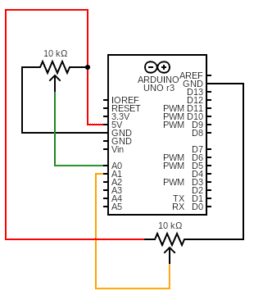Bullying Simulator – Min Jee (Lisa) Moon – Marcela Godoy
Because my project was more of a statement piece, there wasn’t much interaction going on.
- in order to give a first-hand experience of getting bullied by others, I made the project to be on the phone, just like how the victims of the bullied would always receive bullying messages on the phone.
- To resemble the similar terror inside the user’s mind, I added the background sound and the ringtone. (Frankly, I got really sick and terrified of the ringtone of the project ringtone).
- Collected the real text messages that I found on SNS to make the situation realistic.
- Tried to make the project code heavy than the physical part, so that the user can somewhat interact with it, the way users do with their real phone.
For the fabrication,
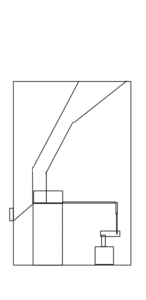
Rastering the laser cutting material
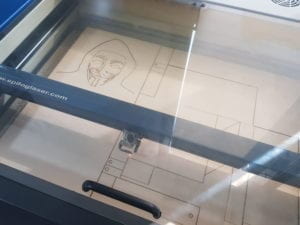
Just like above, I intended the paper role to fall right in front of the hole, into the trash bin, because I thought the bullied are treated like an “emotional trash bin” since all the bad feelings of the bullies would be thrown into bullied as if the bullied are trash bin.
However, during the user testing session, all the users would not get the “emotional trash bin” idea. Due to the outcome from the user testing session, I realized I would have to change my physical part.
What I moved onto (the idea that I got from the user testing session from the test users) the idea of the messages (trash) thrown to the user. As a result, I worked towards the paper roll shooting the trash towards the user.
The first prototype was the one using the DC motor.
As you can see from the video, the stepper would move the push bar to feed the trash messages to the dc motor wheel.
However, as you can see from the above video, the DC motor would throw the trash message to the right front. In addition, the DC motor would get too loud to even make the entire table vibrate. As a result, I decided to change to prototype 2.
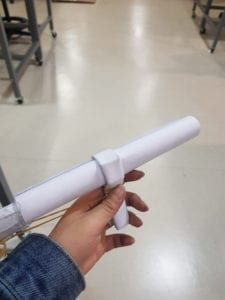
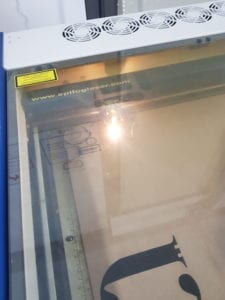
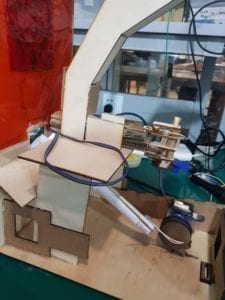
This is the shooter inside the prototype 2. The feeder from prototype 1 was kept the same. If the feeder feeds the trash messages inside the gun, the stepper inside the device would pull on the trigger behind the gun to shoot the trash message towards the user. However, because pulling on the material would be too hard. Therefore, I moved on to the last idea.
For the last idea, I do not have an image or video, but the basic idea can be found here.
Just like the video linked above, when the feeder feeds the trash message paper to the right place, the stepper wheel attached to the catapult would keep on pull on the material, and finally, the servo motor pushing down the catapult would release the catapult, making the trash message to be shot up at the user through the whole.
However, the rubber pulling the catapult would be too weak, and the friction between the wooden boards between the catapult would be too strong to make the catapult shoot up the material effectively, failing the entire physical part’s intention. As a result, I, sadly, was forced to focus all my projects on my coded application part.
HERE is the link to the code bit (The demo of this code bit can be seen from the video at the beginning of this post)
CONCLUSIONS:
This project was motivated by several videos about the suicide video of Amanda Todd and suicide notes of the 13 years old girl K (Korean) who decided to do suicide after continuous bullying. I collected a lot of the real bullying texts that the bullying victims got in their facebook messages, text messages, Kakaotalk (Korean WeChat), etc. to give a realistic experience.
Because my initial and the main attempt was to give the user first-hand experience from the perspective of the bullied, I believe I was able to give a half-successful project. However, unlike my initial attempt of putting the users into the shoes of the bullied and the users tended to view the project in the perspective of the 3rd person’s point-of-view and since this program can only be run on my phone, I think it was still a project that has some space for improvement.
In order to improve this project, I would love to get an approvement from our college and actually publish an actual application that actually sends the messages to the user’s actual phone, which would give more hands-on experience to the user.
I believe this is a very meaningful project after-all because bullying is an ongoing issue all over the world. When I asked the NYU Shanghai students and instructors if they know who to contact if they encounter someone bullying others, nobody was able to answer the question. When I also asked if anybody knows how it feels to be bullied, nobody had a clear idea of how it would feel to be bullied by others. I believe this shows ignorance towards issues like this. Raising awareness to the NYU students and instructors (people whom I presented my project to) would satisfy my initial purpose.


